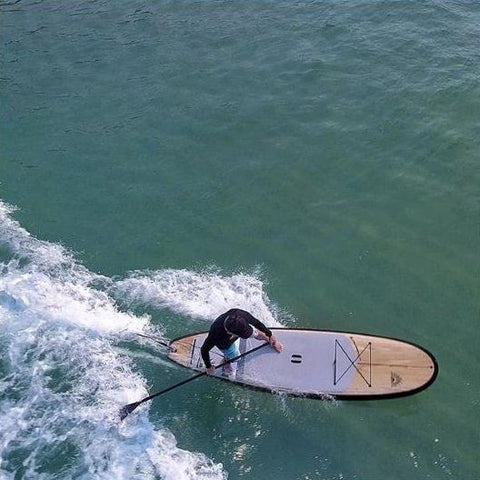You love your stand up paddle board, and want to keep it in the best condition you can.These few simple care and maintenance tips will help make sure that your stand up paddle board looks and performs like new for years to come.
Store Your Paddle Board In The Shade
Hot UV rays are pretty harsh on most things, with SUP boards no exception. Think of the care you give your skin in terms of sunscreen. The same goes for your SUP board. Use it and enjoy it on the water all you want. However, when not in use on the water, find cool shaded storage or cover from hot sun. Excess UV and heat exposure makes your board susceptible to things like delamination, as well as deck pad fading, bubbling and damage. At best, store your board in the shade whenever you aren’t paddling, or at least flip it over so the deck pad gets shade to protect at least the deck pad. You can see more details about heat and paddle boards here.
This is especially the case for boards with dark woody shell, or black painted surfaces. Darker colors absorb the suns’ heat more than lighter colors. When your board is not on the water, and it feels hot to the touch, you should cover it up or find shade! This is the case for the Xplorer Woody, Xplorer SE, Xpedition V-Max Woody 11'6 and 12', as well as the V-Max 12’6 LE, Escape LE, Bliss LE and Blend LE with the carbon black finish.
A board like the Escape LE pictured below will last years longer if you follow these steps!
Avoid Impacts
Paddle boards are really durable if you treat them right. However, the key being you have to treat them right. They do not deal well with impacts into hard things like rocks. Often those with recreational kayak experience will think durability is similar to that of 100lb plastic kayaks, which is very much not the case. You would not drive your fiberglass boat up onto a rock beach or drag it across a pile of rocks, so you shouldn’t do that with your stand up paddle board either. The same applies to cliffs and islands - stay far enough away so you don't hit them!
Sometimes accidents happen though, and if your board does hit something hard enough to cause damage, you want to make sure you get it repaired before going on the water again. This guide will help if you want to try that repair on your own.
The Escape will help you explore anywhere you want to go, but just give the rocks a few feet clearance.
Keep Your Adjustable Paddle Clean
Moving parts and sand don’t often mix well. However, a little preventative care is all it takes to keep your paddle adjusting properly. As the main shaft and handle of Cruiser SUP adjustable paddles slide in and out of each other, grit is really something you want to rinse out of the shaft. At the end of each paddle session, it is a good idea to remove the adjustable handle section of your paddle, and rinse things down with fresh water. If you paddle in fresh water and don’t see much sand near your paddle location, this is something you can do less often. However, if you paddle in salt water, or an area of salt or fresh water with lots of sand, you should do it pretty regularly. This applies for both carbon paddles, as well as alloy paddles.
Don’t Stand Up Paddle Board in Shallow Water
Sure your board is only a few inches thick, but, your fin sticks down into the water 10” and will catch on anything in water shallower than that. Risk of damage to your board aside, you really stand a chance of hurting yourself if you catch your fin in shallow water. If your fin catches on something in shallow water like a rock, you will stop instantly and likely fall right off the front of the board. Falling in deep water is one thing, however, falling in less than 10” of water can be really dangerous!
If you hit your fin in shallow water, there is a pretty good chance your fin will be damaged. At best, you just ding up the leading edge of the fin. But, you can also break the fin entirely, or damage the fin box of the board which is a very costly repair.!
A good rule of thumb is don’t SUP in water less than knee deep! Boards like the Bliss will thank you for it!
Use a Board Bag
A board bag is a great way to protect your investment. Nearly all damage to SUP boards happens not while actually paddling, but in storage and transport. A drop while loading on the roof rack, a rock that flips up off the road while driving are things that a board bag will help protect against. A bag like the Universal Deluxe Bag is fully padded and adds a huge element of protection against the dings and dents that can happen during storage and transportation. Board bags even help reduce the effects of the sun and heat when not in use. As well, with tons of straps and carry handles, a board bag makes carrying your board a lot easier!
Maintain Your Stand Up Paddle Board For Years Of Fun
If you do other sports as well as stand up paddle board, I am sure you care and maintain your other gear as well. You don’t buy a new pair of skis and then go down the rockiest run with the least amount of snow, or take your brand new golf clubs out onto the cement driveway and start taking practice swings. Put these few paddle board care and maintenance tips into action and you will find that board board will last long, look new longer, and performance better over the long run.
Did we miss something? Do you have SUP maintenance tip we should know about? Comment below or email us at info@cruisersup.com





